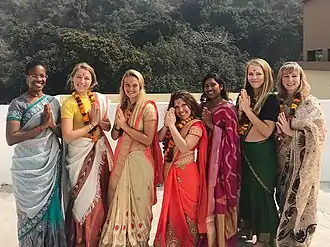Yoga tourism
Yoga tourism is travel with the specific purpose of experiencing some form of yoga, whether spiritual or postural. The former is a type of spiritual tourism; the latter is related both to spiritual and to wellness tourism.[1][2] Yoga tourists often visit ashrams in India to study yoga or to be trained and certified as yoga teachers. Major centres for yoga tourism include Rishikesh and Mysore.

While India is the birthplace of yoga and a major yoga tourism destination, yoga retreats and holidays are provided in many countries, varying from simple stays in guesthouses and ashrams to 5-star comfort in luxury resorts.
Venues

Yoga tourism is not necessarily to an ashram (a Hindu monastery), nor necessarily to India, though as the birthplace of yoga it is the activity's locus classicus. Ashrams offering yoga exist, for example, in Canada.[3] Other possible types of venue describe themselves as "holistic centres" and "yoga holidays", including holidays at "a 5-star resort with a celebrity Yoga Teacher".[3] Yoga holidays are provided in countries including Greece, Sri Lanka, Japan, Thailand, Scotland, France, Morocco, England, Portugal, Spain, Turkey, the Maldives and Wales.[4][5] Yoga retreats can be found in many countries, including for instance Costa Rica and Italy.[3] Hotels and guesthouses around the world similarly offer yoga holidays in countries such as Bulgaria and Turkey; "pastoral yoga" can be found in countries including France.[3]
India
India has become a major destination for yoga tourism, especially since the English rock band the Beatles travelled to Rishikesh in 1968 to take part in a Transcendental Meditation training course at Maharishi Mahesh Yogi's ashram. The visit sparked widespread Western interest in Indian spirituality,[6] and has led many Westerners to travel to India hoping to find "authentic"[7] yoga in ashrams in places such as Mysore (for Ashtanga Yoga) and Rishikesh.[8] That movement led in turn to the creation of many yoga schools offering teacher training and promotion of India as a "yoga tourism hub"[9] by the Indian Ministry of Tourism and the Ministry of AYUSH.[7][10][9]
Reception
Youthful Westerners' sometimes naive spiritual quests to India, and the many varieties of ashram and yoga on offer to them, are gently[11] satirised in the Mindful Yoga instructor Anne Cushman's novel Enlightenment for Idiots.[12][11]
Elizabeth Gilbert's 2006 memoir Eat, Pray, Love, now also a romantic Hollywood film, describes her experiences in an Indian ashram on her journey of self-discovery.[3] Gilbert is thought[13] to have stayed in the Siddha Yoga ashram Gurudev Siddha Peeth in Maharashtra; the film's "Pray" section was set in Ashram Hari Mandir at Pataudi, near Delhi.[13]
References
- Lehto, Xinran Y.; Brown, Sally; Chen, Yi; Morrison, Alastair M. (2015). "Yoga Tourism as a Niche Within the Wellness Tourism Market". Tourism Recreation Research. 31 (1): 25–35. doi:10.1080/02508281.2006.11081244. ISSN 0250-8281. S2CID 167910243.
- Bowers, Hana; Cheer, Joseph M. (2017). "Yoga tourism: Commodification and western embracement of eastern spiritual practice". Tourism Management Perspectives. 24: 208–216. doi:10.1016/j.tmp.2017.07.013. ISSN 2211-9736.
- Lalonde, Angelique M. G. (2012). "Embodying asana in All New Places: Transformational Ethics, Yoga Tourism and Sensual Awakenings" (PDF). University of Victoria Department of Anthropology (PhD thesis).
- Jones, Caroline Sylger (19 June 2017). "The 30 greatest yoga holidays on the planet". The Daily Telegraph.
- Dunford, Jane (7 October 2018). "Perfect positions: 20 best yoga holidays worldwide". The Observer. The Guardian.
- Goldberg, Philip (2010). American Veda: From Emerson and the Beatles to Yoga and Meditation – How Indian Spirituality Changed the West. New York: Harmony Books. pp. 7, 152. ISBN 978-0-385-52134-5.
- Maddox, Callie Batts (2014). "Studying at the source: Ashtanga yoga tourism and the search for authenticity in Mysore, India". Journal of Tourism and Cultural Change. 13 (4): 330–343. doi:10.1080/14766825.2014.972410. ISSN 1476-6825. S2CID 143449133.
- Aggarwal, A. K.; Guglani, M.; Goel, R. K. (2008). "Spiritual & Yoga Tourism: A case study on experience of Foreign Tourists visiting Rishikesh, India". Conference on Tourism in India – Challenges Ahead, 15-17 May 2008, IIMK.
- Singh, Shikha. "Yoga Tourism in India India can be the Wellness Destination for the World". Retrieved 3 December 2019.
- Ward, Mariellen (15 March 2012). "How to 'do' a yoga ashram in India".
- Dowdle, Hillari (2008). "Enlightened Fiction" (March 2008). Yoga Journal: 117.
Each character is ripe for a little satire, which makes the novel a fun read, especially if you're in on the joke... Cushman also manages to capture the heart of their teachings, which gives the book another level of meaning.
Cite journal requires|journal=(help) - Douglas, Anna (September 2008). "Enlightenment for Idiots, by Anne Cushman". Inquiring Mind. 25 (1 (Fall 2008)).
- "Eat, Pray, Love - now try the holiday". Conde Nast Traveller. Retrieved 4 December 2019.

